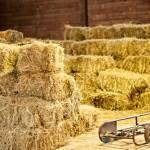Is Cow Hay the Same as Horse Hay?

Almost any horseman in the market for hay has probably stumbled across “cow hay” in advertisements. Unfortunately, there is no hard-and-fast definition for this term, and without that it is difficult to determine if the forage is appropriate for horses.
Generally speaking, hay producers use the term when they realize the hay is not of sufficient quality to interest most horse owners. The hay might contain excessive dust, mold, weeds, foreign debris, or a high stem-to-leaf ratio. Oftentimes, hay is marketed as such because it was knowingly baled under undesirable weather conditions. If, for example, a hay grower knows the hay was rained on, he realizes most horse owners would be uninterested in purchasing it due to the likelihood of mold growth. Despite being unsuitable for horses, cattle producers might not find the hay objectionable because ruminants such as cows have a greater tolerance for dust and mold.
On the flip side, cow hay could mean dairy-quality alfalfa, a pure legume forage that is rich in protein, often over 25%, and therefore inappropriate for most classes of horses.
Because of the ambiguity of the term, the best thing to do is to question the seller about the hay. What grasses and/or legumes make up the hay? Was the hay rained on during the baling process? In what year was the hay baled? What cutting—first, second or third? Have other horse owners purchased the hay and found it to their liking?
If the hay sounds up to par from a verbal description, a site visit is warranted. Ask for several bales to be broken open so you can get a good idea of what the hay looks and smells like on the inside. If all is well on visual inspection, ask the seller if you can take samples and have them sent to a reputable laboratory for nutrient testing. Though few horse owners take advantage of hay-testing services, results can be most telling. An equine nutritionist can help you make sense of the laboratory report if you are unfamiliar with interpreting hay analyses. If the hay turns out to be unsuitable for your needs, be honest with the seller and move on to another source.
An alternative to scouring the countryside for appropriate hay involves the use of different forage sources. Hay cubes come to mind. Though hay cubes made from alfalfa seem to be most widely available, it is possible to buy cubes made from timothy. Check with your local feed stores to see if they stock hay cubes.
The best way to determine if hay is appropriate for horses is by conducting a thorough visual inspection and sending samples for laboratory testing. By doing this, you can be more confident in the forage choices you make for your horses.








